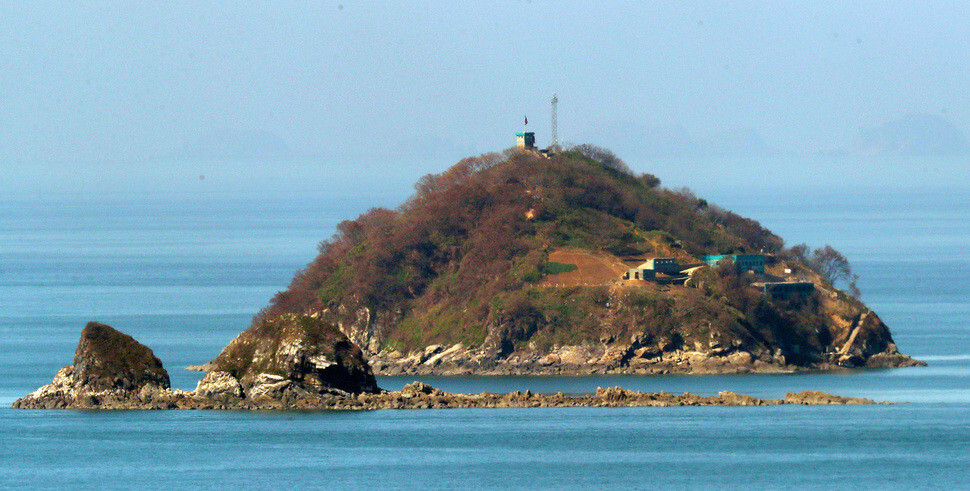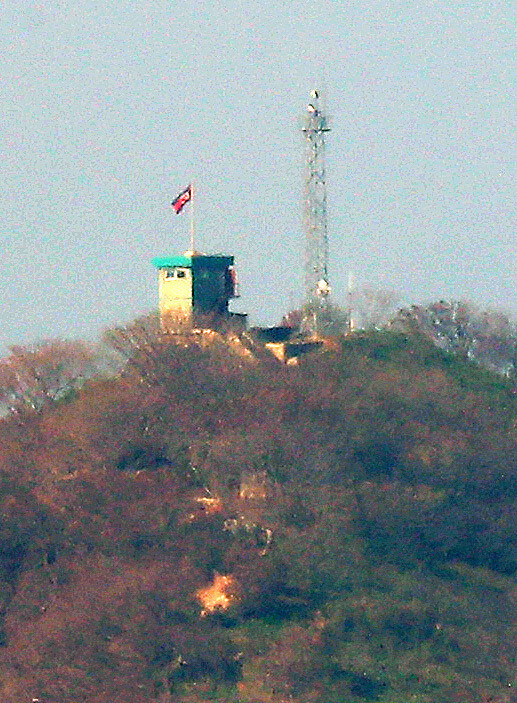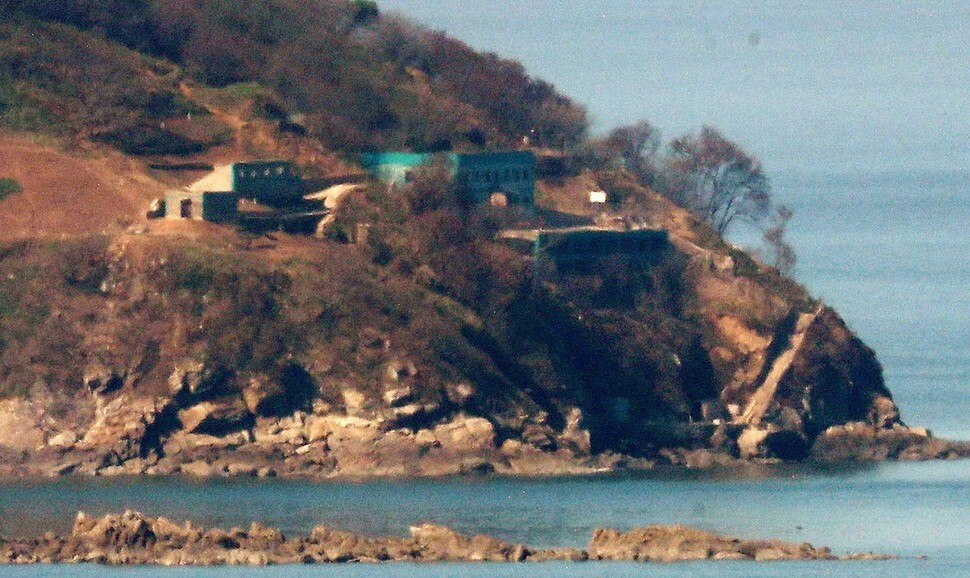hankyoreh
Links to other country sites 다른 나라 사이트 링크
S. Korea media stirs up controversy over N. Korean military facilities on Hambak Island

A South Korean media outlet stirred up controversy with a recent report that what are presumed to be North Korean military facilities had been observed on an uninhabited island near the Northern Limit Line (NLL) in the Yellow Sea.
The fact that South Korea’s Forest Service had given Hambak Island the address “Mountain No. 97, Maldo Village, Seodo Township, Gangwha County, Incheon” raised suspicions that North Korea had set up a military facility in South Korean territory. Some experts poured fuel on the fire by assuming that the structures in question were missile launchers and coastal batteries and claiming that they posed a threat not only to islands in the Yellow Sea but also to Incheon International Airport and the Seoul area.
Even though South Korea’s Ministry of National Defense and the United Nations Command have declared that Hambak Island is north of the NLL, and thus North Korean territory, the controversy shows no signs of abating.
North Korea has reportedly been operating radar and other surveillance equipment since May 2017 at the island, which is about 9km west of Mal Island, in Gangwha County.

The issue at the heart of the controversy over the island is the NLL.
The NLL is a maritime demarcation line that runs between North Korea’s Ongjin Peninsula in Hwanghae Province and South Korea’s five West Sea islands (Baengnyeong Island, Daecheong Island, Socheong Island, Yeonpyeong Island, and U Island). That line was drawn on Aug. 30, 1953, immediately after the Korean Armistice Agreement was signed, by UNC Commander Mark Clark, according to the international principle of three nautical miles of territorial waters, which was in common use at the time.
The land border, known as the Military Demarcation Line (MDL), was finalized in the armistice agreement on July 27, 1953, but the two sides were unable to reach a comparable agreement about a maritime border. North Korea called for 12 miles of territorial waters, out of concern about a naval blockade, while the UNC pushed for three miles. In the end, the armistice agreement only stated that the five West Sea islands are under the military control of the UNC, while omitting any provisions about a maritime line of demarcation.

The inconclusive deliberations about the maritime border in the Yellow Sea eventually became the cause of maritime clashes between South and North Korea. Military tensions between the two sides have continued to simmer because of North Korean crab boats crossing the NLL during June and July.
Since the NLL was drawn unilaterally by the UNC and is not grounded in the armistice agreement, there are various opinions about whether it actually demarcates territorial waters under international law.
According to Lee Jang-hui, professor emeritus at the Hankuk University of Foreign Studies, there are three legal questions about the NLL: whether it’s a territorial boundary, whether it’s a legal military demarcation line, and whether the waters to its south are South Korea’s territorial waters. “The NLL cannot be dealt with on a legislative or judicial level in South Korean society,” Lee said.
“The agreement reached in the Panmunjom Declaration on Apr. 27, 2018, to set up ‘waters of peace’ around the NLL in the Yellow Sea would enable us to make a joint response to illegal fishing by China and other countries and to prevent unintended military clashes,” the scholar added.
By Park Kyung-man, North Gyeonggi correspondent
Please direct comments or questions to [english@hani.co.kr]

Editorial・opinion
![[Column] Has Korea, too, crossed the Rubicon on China? [Column] Has Korea, too, crossed the Rubicon on China?](https://flexible.img.hani.co.kr/flexible/normal/500/300/imgdb/original/2024/0419/9317135153409185.jpg) [Column] Has Korea, too, crossed the Rubicon on China?
[Column] Has Korea, too, crossed the Rubicon on China?![[Correspondent’s column] In Japan’s alliance with US, echoes of its past alliances with UK [Correspondent’s column] In Japan’s alliance with US, echoes of its past alliances with UK](https://flexible.img.hani.co.kr/flexible/normal/500/300/imgdb/original/2024/0419/2317135166563519.jpg) [Correspondent’s column] In Japan’s alliance with US, echoes of its past alliances with UK
[Correspondent’s column] In Japan’s alliance with US, echoes of its past alliances with UK- [Editorial] Does Yoon think the Korean public is wrong?
- [Editorial] As it bolsters its alliance with US, Japan must be accountable for past
- [Guest essay] Amending the Constitution is Yoon’s key to leaving office in public’s good graces
- [Editorial] 10 years on, lessons of Sewol tragedy must never be forgotten
- [Column] A death blow to Korea’s prosecutor politics
- [Correspondent’s column] The US and the end of Japanese pacifism
- [Guest essay] How Korea turned its trainee doctors into monsters
- [Guest essay] As someone who helped forge Seoul-Moscow ties, their status today troubles me
Most viewed articles
- 1[Column] The clock is ticking for Korea’s first lady
- 2Hong Se-hwa, voice for tolerance whose memoir of exile touched a chord, dies at 76
- 3After 2 months of delayed, denied medical care, Koreans worry worst may be yet to come
- 4[Column] Has Korea, too, crossed the Rubicon on China?
- 5Samsung barricades office as unionized workers strike for better conditions
- 6US overtakes China as Korea’s top export market, prompting trade sanction jitters
- 7All eyes on Xiaomi after it pulls off EV that Apple couldn’t
- 8[Guest essay] How Korea turned its trainee doctors into monsters
- 9[Editorial] As it bolsters its alliance with US, Japan must be accountable for past
- 10[Correspondent’s column] In Japan’s alliance with US, echoes of its past alliances with UK